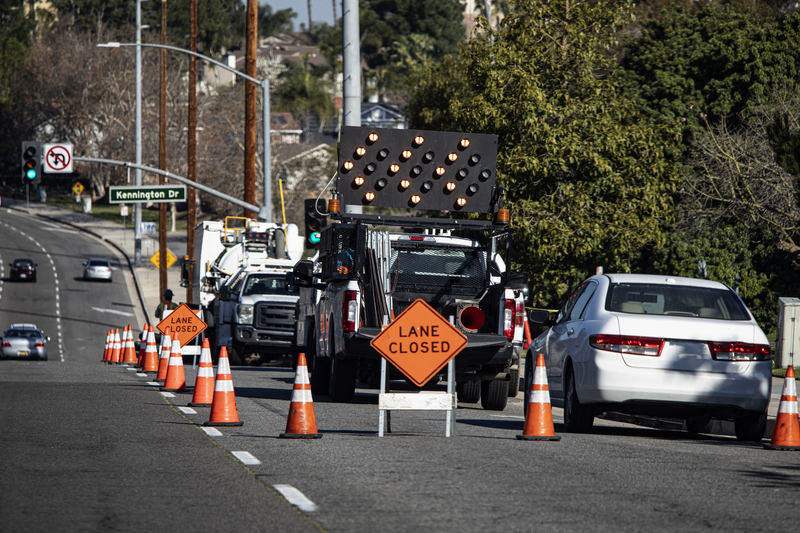Tips for avoiding 'cone zone' fines, accidents

You see them almost everywhere—the ubiquitous orange cones that dot America’s roadways. How can you avoid accidents and traffic fines when driving through the “cone zone”?
“Even experienced drivers become complacent and that leads to collisions in the construction zones, some fatal,” said Anne Staines, a transportation communications expert whose firm has worked with the California Department of Transportation (CalTrans) for the past seven years. “ Departments of transportation across the country are making a concerted effort to get drivers to pay more attention.”
The opportunity for driving problems is great. Consider: Major road construction projects are taking place across the nation—from Florida’s new bridge in Daytona to resurfacing California’s Highway 80.
In 2010, the federal government set aside $27 billion for road repair as part of the American Recovery and Investment Act. As a result, cone zones are sprouting in almost every state and some 4,100 projects are underway.
Cone Zone dangers and enforcement
“Cone zones have become common places for crashes because drivers generally are in a hurry to get somewhere,” Staines said. “Enforcement agencies have stepped up patrols and fines.”
For example, the fines for moving violations in California are doubled if they occur within a construction area.
According to WorkZoneSafety.org, an organization dedicated to educating the public on work zone safety, there were nearly 667 construction work zone fatalities in 2009 as the result of motor vehicle crashes. The National Highway Transportation Safety Administration cites that 85 to 90 percent of highway work zone fatalities are drivers or passengers. States with the highest number of fatalities included Texas, Florida and California, respectively.
“Incidents are related to rear-end collisions. People are not paying attention, cutting into lanes and not allowing enough space between the vehicle in front of you,” Staines says.
Recently, the deaths of three highway workers also urged officials in California to emphasize education programs and stringent enforcement. The “Move Over” campaign emphasizes the right of way for official vehicles including those operating in cone zones.
How to avoid problems
Taking an alternative route is one of the easiest ways to avoid delays and potential incidents. GPS devices can provide alternative routes that could reduce drive time.
“’Know before you go’ is a good rule of thumb,” Staines said. “Drivers can check on numerous resources before they travel.”
Most states offer a 5-1-1 hotline as part of a national Federal Highway Administration program. States who have implemented the 5-1-1 program often provide additional travel information, planning maps, text messaging and sometimes support for multiple languages. It also may be downloaded free from various states as a smart phones app.
“Cone zones often operate around the clock,” Staines said. “States have implemented a variety of early warning systems that give drivers ample time to adjust their speed and direction.”
For instance, changeable message signs have become popular among construction sites and usually appear several miles ahead of the cone zones. Sometimes rumble strips are used as a jarring reminder for drivers to reduce speeds.
“California transportation engineers developed an innovative approach with a retractable beam attached to a tractor-trailer,” Staines said. “It acts as a giant shock bumper in case a vehicle veers into the path of workers.”
The so-called Balsi Beam may be setup easily and quickly. It was named after Mark Balsi, a roadway worker who suffered major injuries when a vehicle swerved into the cone zone.
Drivers can learn more about cone zones and resources at:
- Check on “Move Over” laws, which have been enacted in 43 states. The law requires drivers to yield right of way and change lanes for any official flashing vehicle including road construction crews.
- Ask if your state has specific cone zone laws, which may indicate driving considerably slower than the posted speed. Traffic fines in states such as California are doubled for infractions in work areas.
- Look for early cone zone markers such as messaging boards and rumble strips. Balsi Beams, moveable barriers, indicate active road work areas.
- Visit 5-1-1 traffic websites to find out about road construction areas before you travel. These sites offer a variety of useful information about cone zones and delays.
- Smart phone apps may be downloaded free for Android and iPhone. Check your state’s 5-1-1 site by going to the Federal Highway Administration national site at http://www.fhwa.dot.gov/trafficinfo/511.htm.